Unlocking the Science Behind Cold Water Soaking Benefits
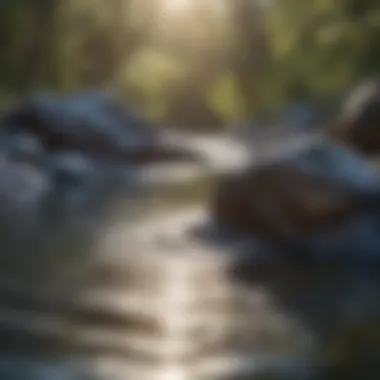

Intro
Soaking in cold water is more than just a shock to the system; it has been a practice steeped in tradition for centuries, embraced by many cultures for its purported benefits. From icy plunges after a hearty workout to brisk baths in frigid rivers, the allure of cold soaking isn't merely the thrill of the chill; it holds significant potential for enhancing well-being. This article explores not only the physiological habits that accompany cold exposure but also how it can serve as a powerful tool for mental fortitude and personal growth.
Nestled within the realms of wellness and athletic recovery, cold soaking manifests in various forms—ice baths, cold showers, and even natural bodies of water. Adrenaline surges, metabolism jacks up, and blood circulation improves, painting a vivid picture of what happens when the body meets cold. However, it doesn't stop there; the mental and emotional ramifications of cold exposure are equally compelling, offering new pathways to resilience and mindfulness.
As we navigate this comprehensive analysis, we'll pinpoint key benefits, strategies for effective integration of cold soaking into daily routines, and real-life successes that underscore its worth. By delving deep into the subject, we aim to provide not only clarity but also a genuine understanding of how such a simple action can yield profound results.
Strategies for Success
As you consider incorporating cold water soaking into your own routine, certain strategies can enhance your success. Here, we explore goal-setting techniques, time management tips, and productivity hacks that align with the practice of cold water exposure.
Goal Setting Techniques
Setting clear, achievable goals is vital, particularly when embarking on a new health practice like cold soaking. Here are some ways to set effective goals:
- Start small: Begin with short exposure times, gradually increasing as your body acclimates.
- Track your progress: Keeping a journal to note your experiences can help in reflecting on the benefits and motivating future sessions.
- Set specific objectives: Whether it's to improve recovery times or enhance mental clarity, clarity in objectives can guide your practice.
Time Management Tips
Finding time for cold soaking within a busy schedule may present challenges. Here are some tips to fit it in:
- Integrate into workouts: Use cold soaking as a post-workout routine to help with muscle recovery.
- Use mornings effectively: A brisk cold shower can jumpstart your day and enhance alertness.
- Prioritize it: Treat cold thermal exposure as an important appointment in your calendar, reinforcing its significance.
Productivity Hacks
Maximizing the benefits of cold exposure can synergize well with your productivity. Here’s how:
- Enhance focus: Cold water exposure can sharpen mental clarity, which can be beneficial when tackling intensive tasks.
- Break the monotony: Utilize cold soaking as a refreshing break during extensive work sessions to rejuvenate your focus and energy levels.
- Pair with mindfulness: Engage in mindful breathing while soaking, ensuring mental benefits accompany the physical ones.
"Cold exposure not only revives the body but invigorates the mind, making it a unique dual benefit worth exploring."
As the practice of cold soaking steadily garners attention, its potential appears limitless. By utilizing these strategies, individuals not only enhance their experience but foster a greater environment for personal growth and resilience. As we continue delving into the physiological, psychological, and emotional benefits of cold soaking, remember that success often lies in the fine details of our approach.
Prolusion to Cold Water Soaking
Soaking in cold water isn’t just a quirky trend; it’s a practice that dates back thousands of years, with roots in various cultures around the world. The act itself sounds simple—submerging the body in cold water—but the underlying benefits are anything but trivial. In this section, we will lay the groundwork for understanding why this practice has garnered attention among wellness circles, athletes, and mental health advocates alike.
One of the most significant aspects of cold water soaking is its impact on the body's physiology. The sensation of cold exposure prompts numerous reactions in the body, engaging several systems that work together harmoniously. Cold water immersion has been associated with improved circulation, helping your heart pump efficiently while sending nutrient-rich blood to different muscles and organs. This not only aids in recovery after strenuous exercise but can also enhance overall well-being by keeping critical pathways in our body operating effectively.
Furthermore, the practice can significantly influence our mental states. When one steps into chilly water, the rush of cold can be invigorating, triggering a release of endorphins, our body’s natural painkillers. This rush creates a sense of euphoria, which can alleviate stress and anxiety, offering a refreshing perspective on both physical and emotional hurdles.
However, it's crucial to recognize that cold water soaking isn't without its considerations. While the benefits are enticing, certain individuals might face risks, particularly those with pre-existing health conditions. Understanding these risks can empower individuals to make informed choices regarding their cold water experiences.
Laying the foundation for this topic, we’ll explore the mechanisms behind cold water exposure, its physiological gains, and its broader emotional advantages.
This comprehensive analysis aims not just to celebrate soaking in cold water but to present it as a valuable tool in one’s health and wellness repertoire.
Understanding Cold Water Exposure
Understanding cold water exposure is pivotal to grasping the multifaceted benefits of cold water soaking. This section aims to shed light on the scientific underpinnings and real-world implications of intentionally exposing our bodies to cold water. Not only is this practice becoming popular in wellness circles, it also has deep roots in historical practices across various cultures. Exploring this concept can unlock a treasure trove of knowledge about how our bodies react to harsh conditions and the significant benefits that follow.
The Concept of Thermal Stress
Thermal stress refers to the physiological responses our bodies undergo when exposed to extreme temperatures. When we plunge into cold water, it triggers a robust reaction. One immediate effect is vasoconstriction, where blood vessels tighten, reducing blood flow to the skin. This skin-tightening process is designed to preserve core body warmth. Yet, there's a flip side: once you exit that chilly water, your body starts to warm up, leading to vasodilation. Blood flow increases, which can enhance circulation.
The experience of thermal stress can actually strengthen our bodily systems. Consider it a natural form of training. Regular exposure to cold water can lead to improved resilience, akin to what athletes do in conditioning drills. This resilience not only applies to physical aspects but also conveys a psychological toughness that can help individuals endure other stressors in life.
"A bit of thermal stress can breathe new life into your daily routine and overall well-being."
Mechanisms of Cold Water Interaction with the Body
When we talk about the mechanisms behind cold water interaction, several physiological responses come into play. First, let’s examine how the body reacts at the cellular level. Cold exposure can stimulate the production of norepinephrine, a hormone associated with mood and brain function.
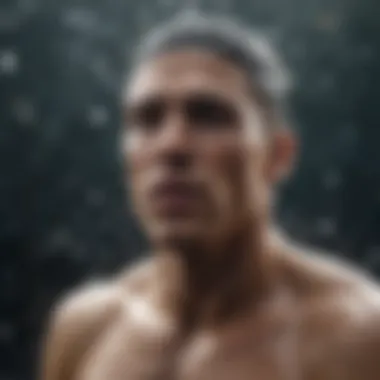

In addition, cold water exposure engages the body's sympathetic nervous system, which is responsible for our fight-or-flight responses. Engaging this pathway can naturally enhance alertness, activate the immune system, and even elevate mood levels. Research suggests that these reactions are not merely transient; they might have long-lasting effects on our mental health and physiological functioning.
Also noteworthy is the role of brown adipose tissue—a special type of fat that generates heat. Cold water exposure can activate this type of fat, facilitating energy expenditure and potentially aiding in weight management. Thus, cold water soaking can serve a dual purpose: jumpstarting metabolism while simultaneously offering mental clarity and heightened alertness.
In summary, understanding how cold water interacts with our bodies encompasses a broad range of physiological changes that lead to significant benefits. The key is recognizing that this practice can be quite transformative. It’s not merely about taking a chilly dip; it’s about embracing the depth of these responses to become a more resilient and balanced individual.
Physiological Benefits of Cold Water Soaking
Delving into the physiological benefits of cold water soaking reveals a treasure trove of advantages that go beyond the initial chill one might feel. This practice, rooted in ancient traditions, has recently resurfaced in modern wellness conversations. It addresses not merely the body's surface but delves deeper into its intricate systems, making it essential for athletes, wellness enthusiasts, and anyone keen on maintaining their health and vitality.
Enhancement of Circulation
Cold water exposure has been shown to boost circulation markedly. When the body is submerged in cold water, it experiences a constriction of blood vessels, known medically as vasoconstriction. As we step out, these blood vessels expand or vasodilate, leading to increased blood flow. This two-way action supports effective nutrient delivery and removes waste products from tissues. Improved circulation is particularly invaluable in a world where sedentary lifestyles have become pervasive.
"Cold water soaking acts like a reset button for circulation, invigorating blood flow much like a brisk walk on a frosty morning."
In practical terms, enhanced circulation can aid in the recovery process for anyone who has pushed their physical boundaries, providing a natural way to expedite healing and reduce fatigue.
Inflammation Reduction
Soaking in cold water is also touted for its role in curbing inflammation. It’s no surprise that swelling often accompanies physical exertion, be it post-workout soreness or chronic conditions. Cold exposure can dampen the inflammatory response, which may come in handy for athletes recovering from intense training or injury.
Research suggests that the cooling effect reduces the release of inflammatory markers in tissues, promoting a quicker return to equilibrium. It’s vital to note, however, that while cold water soaking is beneficial, it should not replace medical treatments for chronic inflammation issues.
Muscle Recovery and Pain Relief
One of the most talked-about aspects of cold water soaking is its impact on muscle recovery. The abrupt exposure to cold reduces muscle soreness far more effectively than simple rest alone. Athletes often take ice baths post-exercise, but the benefits extend beyond just elite sport.
The cold bath stabilizes acid buildup in muscles, thus preventing delayed onset muscle soreness, commonly known as DOMS. Furthermore, the cold drains lactic acid, allowing muscles to recover faster. For individuals struggling with chronic pain conditions, a cold soak can provide an accessible form of relief without the need for medications.
Boosting Immune Function
Emerging evidence suggests that regular cold water exposure may bolster the immune system. This is particularly intriguing, as it implies that daily practices of cold water soaking can enhance one’s defense against common illnesses.
Specifically, studies indicate that exposure to cold leads to increased production of white blood cells, which are crucial for fighting off infections. Additionally, it may trigger a heightened response to stress that primes the body’s defenses for potential threats.
In the realm of wellness, this is consequential; not just for preemptive health but also for maintaining performance in fast-paced environments where mental acuity and physical resilience are prized.
In closing, the physiological benefits of cold water soaking are substantial. The intertwining effects on circulation, inflammation response, muscle recovery, and immune function present a compelling case for integrating this practice into daily routines. By embracing these benefits, individuals are better equipped to navigate the demands of life, both physically and mentally.
Mental and Emotional Advantages
When delving into the practice of cold water soaking, one might primarily think about the physical benefits. However, the mental and emotional advantages are equally significant, shaping not only how we feel in the moment but also how we approach life overall. These benefits offer a holistic upgrade to one's lifestyle, making cold water exposure a potent tool for mental resilience.
Stress Relief and Relaxation
Soaking in cold water can trigger a cascade of psychological benefits, chief among them being stress relief. The shock of cold water activates your body's fight-or-flight response but in a controlled manner. As your body learns to adapt to the chill, it cultivates a sense of calm. This paradox helps to lower overall stress levels. It’s like stepping into a cool pool on a sweltering day—the initial shock fades quickly, replaced by a profound sense of relaxation.
Why does this happen?
Cold water lowers the levels of cortisol, the hormone responsible for stress. Over time, regular exposure can serve as a method for learning how to manage stress better. Despite the immediate discomfort, many report feeling invigorated and rejuvenated afterward, often attributing this sensation to a cleansing of emotional burdens.
Improved Mood and Mental Clarity
Beneath the chilling surface, one can find an unexpected boon: an uplifted mood. Research suggests that cold water soaking can lead to the release of endorphins and other feel-good hormones. This is particularly valuable in combatting feelings of sadness or anxiety. Many individuals describe a post-soak euphoria akin to a runner's high, leading to increased overall happiness.
Moreover, engaging in such a stimulating experience enhances mental clarity. When your body is plunged into cold water, it demands focus. You’re forced to be present in that moment, which can help clear mental cobwebs. This clarity can carry over into daily tasks, improving productivity and decision-making. Think of it as a mental reboot, where muddled thoughts are washed away, making space for new ideas and perspectives.
"Cold water immersion can feel like a reset button for your mind, washing away the fog of daily stress."
Enhancement of Focus and Concentration
Cold water soaking isn’t just about relieving stress or boosting mood; it significantly tweaks our focus and concentration. The initial exposure elevates adrenaline levels, sharpening alertness. Imagine diving into a sudden wave at the beach—there’s an undeniable jolt that pulls you into the now, sharpening your senses.
Regular practice can train your brain to respond more positively to distractions. It’s akin to strengthening mental muscles—much like physical workouts improve bodily functions. With time, dedicated cold exposure can transform how a person tackles complex tasks or navigates stressful scenarios, leading to performance improvements in both work and personal tasks.
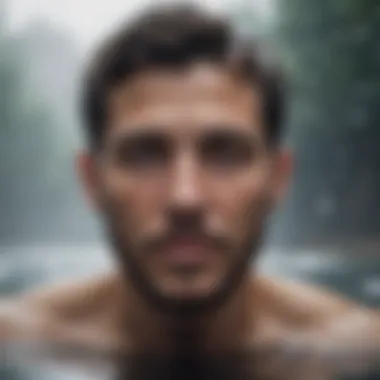
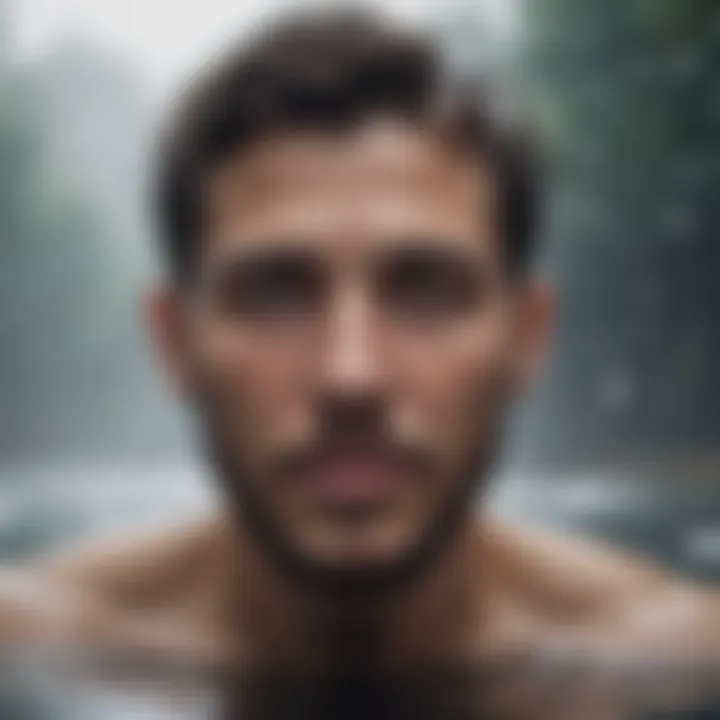
Cold Water Soaking for Athletes
Athletes are always on a quest for the best ways to keep their bodies in tip-top shape, pushing through pain and fatigue. Cold water soaking has carved out a niche for itself in the realm of sports recovery. The unique properties of cold water can help athletes not just in bouncing back physically, but also in improving their overall performance. This section will explore the vital role cold water soaking plays in the world of athletics, diving into recovery protocols and scientific studies that back its efficacy.
Recovery Protocols in Sports
Recovery is where the magic happens after a grueling workout. Cold water soaking has been utilized for decades as a protocol for recovery. It creates a dance of contraction and relaxation within the muscles that’s akin to a well-choreographed ballet. When an athlete immerses themselves in frigid water, the blood vessels constrict and then dilate upon exit from the cold. This cycle helps flush out waste products from energetic use, such as lactic acid, which can otherwise lead to soreness.
- Reduced Delayed Onset Muscle Soreness (DOMS): Athletes often report less stiffness and soreness in the days following an intense workout if they soak in cold water post-exercise.
- Faster Return to Activity: With reduced muscle damage and inflammation, many find they can get back to training quicker than if they relied on passive recovery methods.
- Psycho-Emotional Edge: The mental aspect cannot be overlooked. The initial shock of cold plunges can offer a test of one’s willpower, acting as both a physical and psychological reset, preparing one for future challenges.
"Cold water is like nature's recovery tool; it’s simple, effective, and available to anyone willing to take the plunge."
Performance Enhancement Studies
Research shines a spotlight on how cold water soaking can be a game changer for athletes seeking to up their performance. Numerous studies have dabbled in the relationship between cold immersion and athletic output. It goes beyond just soothing muscles to actually bolstering performance.
- Increased Blood Flow: Several studies have indicated that cold exposure can lead to enhanced blood flow post-soaking. This increase in circulation not only aids in recovery but can also prime muscles for better performance.
- Improved Endurance: Athletes employing regular cold water soaks have been observed to show marked improvements in endurance during competitions, possibly due to lower perceived exertion during prolonged activities.
- Cognitive Benefits: Cold exposure can contribute to heightened alertness and focus. Research suggests that athletes often experience sharper mental acuity after cold soaking, which directly feeds into better decision-making during high-stakes competition.
With both protocols and studies painting a robust picture, it’s clear that cold water soaking isn’t just a trendy practice—it’s a serious tool in an athlete’s arsenal. Incorporating cold water soaking into training routines, therefore, becomes not just a choice but a strategy for serious contenders in the athletic arena.
Cultural Perspectives on Cold Water Soaking
Cold water soaking isn't just a health trend that popped up yesterday. It’s baked into the culture of many societies around the world. This section peels back the layers to reveal how different cultures have embraced this practice, highlighting both historical practices and modern rituals. It's more than just a chill; there’s depth to this phenomenon that reflects human connection to nature, wellbeing, and even social identity.
Historical Practices Across Cultures
Throughout history, cold water bathing has manifested in diverse forms. In ancient Greece, for example, the practice of using cold water was favored by philosophers as a rejuvenating method. They thought that immersing oneself in cold water could clear the mind before delving into deep thought. Fast forward to Japan, where the tradition of Misogi, a ritual purification practice involving river or ocean immersion, has been a staple for centuries. It symbolizes not only spiritual cleansing but also physical renewal.
In Russia, the Banya sauna experience often includes plunging into icy lakes or snow after a heated sauna session. This practice encourages a cycle of thermal stress that invigorates the body. Similarly, Finland has its own take with the concept of sauna, where a brisk dip in cold water post sauna enhances circulation and boosts resilience. It’s fascinating to think that what might sound like a modern wellness hack has its roots firmly entrenched in the annals of cultural history across continents.
Modern Rituals and Trends
Today, many have taken these age-old practices and reimagined them in light of contemporary lifestyles. You see the trend of cold exposure taking off on social media, particularly amongst fitness enthusiasts and holistic health proponents. Ice baths, polar plunges, and even Wim Hof Method—where extreme cold exposure techniques are mingled with breathing exercises—have garnered a loyal following.
In some urban communities, cold water soaking has turned into organized events. Think of groups that come together for communal dips in chilly natural bodies of water, sometimes donning costumes or themed gear, all aimed at fostering community spirit. And it’s not just about being cold; it’s also about connection—being part of something bigger and sharing the experience with like-minded folks.
Not to mention, there’s a growing collection of personal anecdotes emphasizing its effects on mental health. Whether it's a way to cope with stress, a method for grounding oneself in the present, or a challenging way to shake off the daily grind, the modern practices continue to reveal layers of psychological and emotional significance.
In essence, whether through ancient rituals or contemporary practices, cold water soaking serves as a bridge—a means of connecting individuals to their surroundings, each other, and themselves in profound ways.
These cultural perspectives on soaking in cold water highlight its role as a multifaceted practice that extends far beyond mere temperature. It's a deep-seated human interaction with nature that can elevate one's overall health and community experience.
Safety Considerations and Contraindications
When it comes to the benefits of cold water soaking, ensuring safety is paramount. While many individuals tout the myriad advantages, it’s crucial to recognize the potential risks that can arise if proper precautions aren't taken. Understanding these considerations can mean the difference between a refreshing experience and a dangerous situation.
The risks associated with cold water exposure, particularly hypothermia, warrant careful attention. This section will delve into these important elements to help you navigate your cold water journey safely.
Understanding Hypothermia Risks
Cold water immersion can be a cold slap of reality. Hypothermia is not just a word; it's a condition where the body temperature drops to dangerously low levels. In temperatures below 60°F (15°C), a person's risk of hypothermia increases significantly. Symptoms can include shivering, confusion, lack of coordination, and in severe cases, loss of consciousness.
For example, a study conducted on individuals who immersed themselves in cold water for extended periods revealed that many underestimated the quick onset of hypothermia. To illustrate:
- Cold Water Temperature: Immersing in 50°F (10°C) water can lead to hypothermia symptoms in just 30 minutes.
- Body Composition: People with lower body fat may experience hypothermia more quickly than those with a higher percentage.
- Duration of Exposure: Even a few minutes might be enough in frigid water.
Being aware of these factors is essential for anyone considering cold water soaking. Always check the water temperature and set benchmarks for your duration based on the climate and your personal tolerance.
"Safety first accompanies every adventure into cold waters. Make informed choices!"
When to Avoid Cold Soaking
There are circumstances where choosing to avoid cold water soaking is wise for your well-being. Here are some situations when you’d want to think twice:
- Pre-Existing Conditions: Individuals with cardiovascular problems should be particularly cautious. Cold exposure can constrict blood vessels and elevate heart rates, leading to undue stress on the heart.
- Illness: If you're feeling under the weather, it’s often best to skip the cold soak. The body needs to focus on recovery, not adapting to temperature extremes.
- Extreme Temperatures: If the air or water temperature is extremely cold, the risks multiply. Avoid soaking in icy waters during harsh winter months, especially without proper gear.
In summary, while cold water soaking presents plenty of benefits, it also comes with its fair share of risks. By understanding hypothermia and recognizing when to avoid the practice, cold water can be a refreshing ally rather than a chilling adversary.
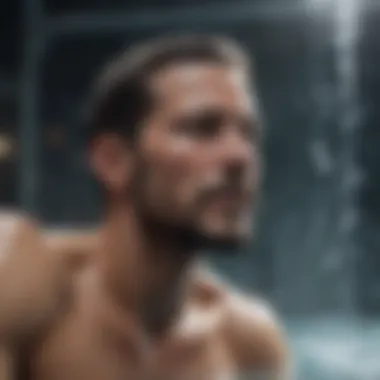
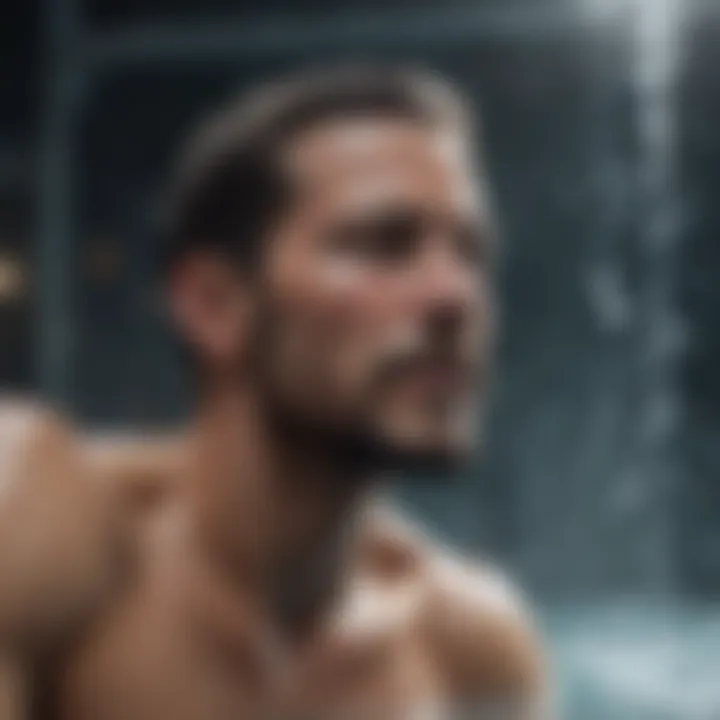
Practical Guide to Cold Water Soaking
The practice of cold water soaking isn't just something athletes do for an edge—there's more to it than that. It serves as a bridge between wellness and recovery. By truly understanding how to set up, benefit from, and incorporate this practice into daily life, individuals can tap into a wealth of advantages, ranging from physiological benefits to emotional resilience.
Cold water soaking can be a game-changer, provided that one approaches it thoughtfully. It's not merely about jumping into icy water and hoping for results. There’s a method to the madness, and this guide delves into the nuts and bolts of how to make the most of cold water exposure.
Setting Up Your Cold Water Experience
Creating an optimal cold water soaking environment doesn't require a PhD, but it does need some thoughtful preparation. First, decide where you’ll be soaking. The bathtub, a cold plunge tub, or even a natural body of water can work well—just ensure it’s safe and accessible. Then, consider the temperature. Generally, water below 60°F (about 15°C) is considered cold for soaking. If you're feeling ambitious, aim for even lower temperatures.
Additional setups can help enhance your experience:
- Clothing: Wear something warm nearby—once you get out, you'll want to wrap up quickly to avoid chilling further.
- Timing: Have a timer handy for safety. Soaking for too long can lead to unintended consequences like hypothermia.
- Mindset: Before hopping in, take a moment to center yourself. A calm mind can improve your overall experience.
"Cold water therapy isn't just a physical challenge. It's as much a mental hurdle as it is a medical marvel."
Duration and Frequency Recommendations
When diving into cold water, what’s the sweet spot for duration? While it can vary based on individual tolerance, a good starting point might be about 10-15 minutes. Gradually increasing duration as your body adapts is wise. However, listening to your body is key—if you're shivering uncontrollably, it might be time to exit.
As for frequency, soaking two to three times a week typically garners positive responses from those who practice regularly. This consistency can facilitate improved recovery, enhanced circulation, and even mental clarity over time, helping to create a beneficial ritual that fits seamlessly into a fast-paced lifestyle.
Incorporating Cold Water Soaking into Your Routine
Integrating cold water soaking into everyday life should feel less like a chore and more like an invigorating boost to your wellness arsenal. Consider using it as a reward after physical activities, like workouts or hikes.
To maintain regularity:
- Scheduled Soaks: Put it on your calendar to establish a routine. Consistency is key for long-term benefits.
- Pairing with Other Practices: Some find that combining cold water soaking with breathing techniques or meditative practices enhances the experience.
- Group Activities: Include a friend or family member. Sharing the experience can make it more enjoyable and motivate you to keep at it.
Ultimately, adopting cold water soaking into a daily routine is about fostering a personal commitment to well-being. In the hustle and bustle of life, these little moments of pause—where body and mind converge in a chilly embrace—can yield profound results.
Future Research Directions in Cold Water Therapy
The realm of cold water therapy is ripe for exploration, a fact that could bring forth numerous insights beneficial for both casual enthusiasts and serious practitioners alike. While current studies highlight its various benefits, the depth of potential applications remains underexplored. Understanding how cold water affects us over extended periods could revolutionize wellness practices and therapeutic applications. As we continue to peel back the layers of this intriguing field, several key areas stand out for future investigation.
Exploring Long-Term Effects
Research into the long-term effects of cold water soaking could yield significant revelations. Studies so far have primarily concentrated on immediate benefits such as reduced muscle soreness and improved circulation. However, understanding how regular cold exposure influences metabolic rates, cardiovascular health, or even psychological resilience over time is vital for both athletes and general users. Potential aspects to investigate include:
- Sustained Inflammation Management: Are there long-term improvements in inflammatory markers after consistent cold exposure?
- Cardiovascular Health: How does repeated exposure to cold water alter heart function or blood pressure over the years?
- Mental Resilience: What implications does cold water therapy have on chronic anxiety or depressive symptoms over time?
In addressing these inquiries, researchers might provide insight into whether the practice can significantly enhance quality of life or athletic performance as part of a robust wellness routine.
Potential for New Therapeutic Uses
In addition to understanding long-term impacts, there’s a treasure trove of potential therapeutic applications awaiting exploration. Cold water therapy may hold the key to treating various conditions, transcending traditional usages like recovery from sports injuries. Possible areas for therapeutic innovation could include:
- Pain Management: Investigating how cold water therapy can serve as an alternative to pharmaceuticals for chronic pain conditions.
- Mental Health Treatments: Could systematic cold showers be incorporated into treatment regimens for those suffering from PTSD or anxiety disorders?
- Enhancing Rehabilitation Protocols: Developed methodologies that employ cold exposure alongside traditional rehabilitation for a variety of injuries could be incredibly useful.
"The broader implications of cold water soaking extend beyond mere recovery; they may shape how we think about personal health management entirely."
The benefits explored in existing literature combined with emerging findings can help establish new protocols that leverage cold water's efficacy for enhancements in physical therapy, mental health treatments, and perhaps even longevity strategies. As science continues to study the interplay between cold exposure and various physiological and psychological responses, a clearer picture will emerge, paving the way for informed practices that may truly change the landscape of health and wellness.
Culmination
As we draw this discussion to a close, it becomes clear that cold water soaking is not merely a trend; it's a practice steeped in both science and culture. As we've explored the numerous benefits—from physiological enhancements such as improved circulation and reduced inflammation, to mental advantages like heightened clarity and focus—it's evident that this practice can serve as a robust tool for personal development.
The physiological aspect deserves particular attention. Soaking in cold water stimulates blood flow, which not only helps in muscle recovery but also gives the immune system a gentle kick, making it more resilient. Each dip creates a mini workout for your circulatory system, essentially putting it through its paces. This is crucial, especially for those looking to maintain peak physical condition.
Adopting cold water soaking also has much to offer in the realm of mental health. The practice encourages mindfulness and can serve as a profound respite from the everyday hustle. Being enveloped in cold can also trigger a powerful psychological response, promoting a sense of well-being. It's a chance to reconnect with oneself, to take a breather amidst life's chaos.
However, it’s wise to approach cold water soaking with caution. While the benefits are many, there are also risks, such as mild hypothermia, that must be taken into account. Understanding when to avoid this practice is just as vital as knowing when to embrace it. Therefore, a sensible approach is always recommended—perhaps starting with shorter durations and gradually increasing exposure as comfort allows.
In summary, cold water soaking embodies a delicate balance of ancient practices and contemporary wellness trends. As we've examined, its multifaceted benefits provide compelling reasons to consider integrating it into one's routine. Whether you're an athlete pushing boundaries, a professional seeking clarity, or simply someone interested in holistic health, there's something to gain from this practice. It invites exploration, not only in what it can offer physically and mentally but also in how it can augment anyone's lifestyle.
"Cold water doesn't just cool the body; it awakens the spirit."
As we conclude, it is important to keep an open mind regarding future research directions in cold water therapy. There’s still much to unravel about its long-term effects and potential therapeutic applications. With each dive into that chilly abyss, who knows what new discoveries await?



